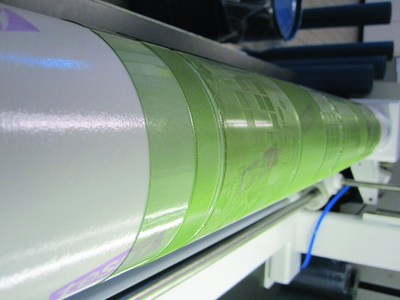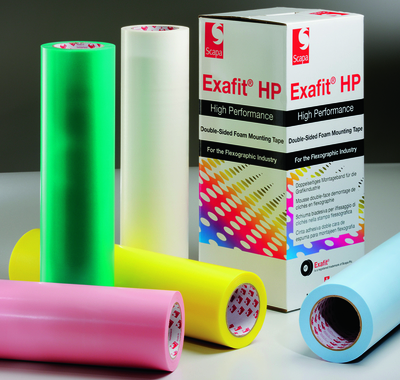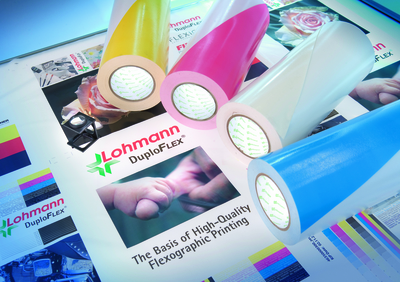Lohmann’s DuploFlex range of tapes
Tapes for mounting of flexographic photopolymer printing plates are available in different levels of hardness and thickness to accommodate the exact printing conditions for which they are needed. Neel Madsen spoke to the manufacturers about the importance of finding the right product.
Double-sided adhesive tapes for plate mounting were first introduced in the 1970s and have over the years developed into the complex constructions we see today, in step with increasingly sophisticated plate technology and faster printing press speeds. The demand for higher productivity and less waste put more pressure on all components, and it is important for printers to evaluate each element individually to ensure there are no weak links or bottlenecks in the production process.
The quality of the plate mounting tape will have a significant impact on the final print result, and using the wrong product can cause issues such as plate lifting and dot gain to name but a few. The basic tape structure consists of a compressible foam layer laminated to a filmic material to stabilise the construction, which has adhesive on both sides and a release liner on one. The density, and thereby the compressibility, of the foam varies, but in general softer tapes are used for halftone work and harder ones for solids to support the printing elements sufficiently. There are also a number of products for printing jobs combining halftone and solids in one plate.
Applying the tape to the printing cylinder or sleeve can either be done by hand applying pressure with a rubber roller or by using a plate mounting machine for a more uniform and bubble-free application.
Supreme winner
Bob Drew, national sales manager of Lohmann Technologies UK, said that the demands on the plate mounting tape and need for it to perform are greater than ever before. ‘With the step up from ‘traditional repro’ to ‘high resolution’ repro systems, the requirement to print finer and finer images has increased. Tonal image areas are more extensive with more vignettes being produced and solids being originated from tones, etc. The improvement trend continues with the impression settings on ever more sophisticated presses, ink transfer from the plate improvements, speed of production increases, all contributing to improved quality of image.’
The key characteristics of the tape need to embrace a vast number of variables, including substrate (film, polyethylene, bio-degradable, polyester, laminates, metallised, paper, coated and uncoated), plate variations (solvent, waterwash, thermal, in varying hardnesses), ink types (solvent, water or UV), press speeds and run lengths. Mr Drew said, ‘One of the primary characteristics is the compression and recovery of the foam. This must be consistent throughout the entire duration of the production run. There is also the adhesive to consider, adherence to the sleeve, cylinder (various finishes), adhesion of the plates ensuring the plates stay in position and the edges do not lift, removal of the plates without damage and in many cases re-use of the tape.’
This may seem simple, but consider a 500 mm repeat running at 900 m/min (a print trial run by Lohmann in conjunction with co-suppliers to the industry). In this case, the tape needs to compress and recover 1,800 times every minute which allows a recovery time of just 0.033 seconds per repeat.
The company has over the years received a number of awards for its plate mounting tapes, and in 2013 it was successful in no fewer than five different print categories at the FlexoTech Awards. The awards saw prizes awarded for the quality of the prints in ‘Labels’, ‘UV flexo, paper and board’, ‘Flexo job previously printed by another process’, and ‘Best use of flexo within a single forme’, all to entries using Lohmann tapes.
Mr Drew said that the company was particularly delighted that Belarussian firm JV Uniflex Ltd won the Supreme Award. He commented, ‘By winning this special prize, JV Uniflex has demonstrated that flexo printing can produce excellent print results when the right products are used. ‘The company has been using our DuploFLEX 5 tapes for two years. These are characterised by their ease of handling, easy removal and most importantly, a perfect print result. Thanks to the unique flexible PE film on both sides, the forces acting on the foam are perfectly cushioned to provide the ideal print result. Quality wins through at all levels!’
The DuploFLEX 5 range is equipped with a double-sided flexible PE reinforcement and is available in four different degrees of foam hardness (soft, medium soft, medium firm and firm) and three degrees of adhesive properties (standard, plus and ultra).
Softness
Arnoud de Jong, international product and market manager for tesa, explained that although the general principle that a soft tape is suitable for screen work and a hard tape is best for solids still applies today, new plate types and hardnesses mean that more variations of mounting tape are needed to support better process efficiencies across an even wider range of applications. He said, ‘The foam itself is the spine of the product. It is commonly recognised that a closed cell foam recovers better and faster than an open cell foam. The rounder these closed cells are, the better the recovery.
The formulation of these foam types often varies, but all have their own specific benefits with varying degrees of strength, resilience and stability, to name just a few key properties.’
The durometer, or the hardness, of a plate influences which specific elements can be printed best. Overall, the harder the plate, the better it is for printing screens. The application of a very soft tape may lead to poor ink transfer from plate to substrate, and the need to overimpress to enhance ink transfer. A slightly harder tape would have a more positive influence without overimpressing and this benefits the lifecycle of the plate mounting tape and the plate itself. When the tape is too hard, banding or bouncing may occur. On projects where two or more designs are printed next to each other, this can sometimes be overcome by increasing or decreasing the print speed slightly, or changing the way plates are mounted, explained Mr de Jong.
 Plate mounted with Softprint Fast & Easy tape from tesa
Plate mounted with Softprint Fast & Easy tape from tesa
Film for stability
The stabilising film in the tape is a vital part of the construction as it contributes to the holding power. A relatively rigid stabilising film allows the tape and plates to be mounted without the foam being stretched, eliminating caliper deviations. ‘The influence this has on the compression of the tape during printing is something that should be addressed across the entire application,’ said Mr de Jong. ‘If, for example, a polyester backed plate is 5 to 10 times thicker, a thin stabilising film will complement this and help to enhance the print performance.’
The benefit of a more rigid stabilising film lies in the dimensional stability making the process of demounting a plate, without stretching or lifting the tape, a lot easier. The contact that is made during the demounting process should be kept to a minimum to avoid tape lift and demounting occurring over a large area. tesa’s Softprint range of tapes are available in a number of hardness levels, and the tesacohesion programme, which is defined by four core elements: people, products, processes and performance, make up its customer service offering. This is provided in combination with advice on the most appropriate solution and ongoing technical support.
 Scapa’s colour-coded range of tapes
Scapa’s colour-coded range of tapes
Colour coded
Scapa said that in the last seven years, the company has increased its focus on the graphic and printing industries to develop highly specialised tapes to ensure high quality printing results, which are essential to the flexible packaging markets.
Its Exafit range offers both standard and specialist products, and is produced in three different hardness levels (colour-coded for easy identification) and also three adhesive levels. Key products are produced in 400 microns and 550 microns thickness with thicker options available.
For very demanding halftone printing,the company recommends Exafit soft pink foam. For solid print type, the blue range is harder and ensures better ink transfer, while medium (white) foam is offered for a combination of halftone and solid print.
These products use specialist acrylic adhesive technology, which allows a strong contact to be maintained between the tape and the plate during the print process. This adhesive has the added benefit of providing great solvent and chemical resistance while allowing for easy repositioning during the application of the plate onto the tape and clean, residue-free removal.
The Exafit High Performance (HP) range was launched last year. It allows for longer, faster print runs with consistently high print definition and reduced dot gain. Contrast and details are kept consistent and the colour density is preserved. Its improved surface coverage contributes to superior results from halftone to solid printing.
It features a new type of PE foam with improved resilience which helps to absorb any tolerances caused by variable substrate thickness and machine vibration.
Since the mounting process of the tape is crucial, Scapa has introduced a new transparent PP embossed filmic liner, which is easy to remove, improves the removal of air bubbles and leads to easier repositioning during the plate mounting process.
The company said that its future plans include increasing its presence in North America and Asia, while India and Russia also show good potential for growth.
No bubbles
3M makes its Cushion-Mount Plus tapes in eight different foam densities, as well as a range of adhesives and levels of thickness for optimal print results.
For additional performance benefits, its E-Series and EH-Series of tapes offer features that improve productivity and ease of use. They are designed with patented micro channels that allow air to flow through the adhesive, helping bubbles disappear from between the tape and plate, and between the tape and cylinder or sleeve. With virtually bubble-free mounting, this means a reduction in waste and increased productivity while also achieving cleaner print quality.
E-Series tapes have a 3M proprietary plate-side adhesive that maintains tight contact, saving prep time, downtime and the labour of sealing plate edges. It also peels off easily, reducing plate damage and plate back treatment. EH-Series tapes offer higher plate-side adhesion to resist edge lifting on cylinder diameters from 2 inches.
The company suggests that the implementation phase of a new press or plate technology is the ideal time to optimise mounting tape selection.
There are several variables that contribute to optimal tape performance, including press speed, plate imaging technology, plate exposure, plate material (durometer), high resolution screening and surface characteristics.
It has customer service and technical service support representatives who offer extensive expertise and ongoing education opportunities.






